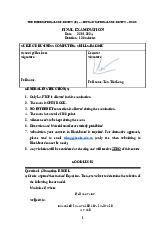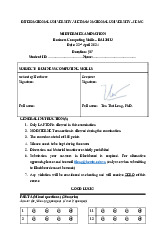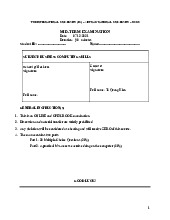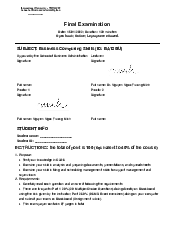







































Preview text:
lOMoARcPSD|364 906 32 Lecture 03 Computer Software McGra D
wo-wn Hilo
lla/d I e r d w b i y n H
©2008,The McGraw-H oa Minh
ill Companies, All Rights Reserved (minhhoaanthea@gmail.com) lOMoARcPSD|364 906 32 Learning Objectives
1. Describe several important trends occurring in computer software.
2. Give examples of major types of application and system software.
3. Explain the purpose of several popular software packages
for end user productivity and collaborative computing.
4. Define and describe the functions of an operating system. 4- 2 lOMoARcPSD|364 906 32
5. Describe the main uses of computer programming
software, tools, and languages. 4- 3 lOMoARcPSD|364 906 32 4- 4 Types of software lOMoARcPSD|364 906 32 Software types • Application software
– Performs information processing tasks for end users • System software
– Manages and supports operations of computer systems and networks 4- 5 lOMoARcPSD|364 906 32 Application software • General purpose
– Programs that perform common information processing jobs for end users
– E.g., word processing, spreadsheet, etc.
– Also called productivity packages • Application-specific
– Programs that support specific applications of end users 4- 6 lOMoARcPSD|364 906 32
– E.g., electronic commerce, customer relationship management, etc.
Software classifications
• Classify based on how it was developed • Custom software
– Software applications that are developed within an
organization for use by that organization • COTS software
– Commercial Off-the-shelf (COTS) 4- 7 lOMoARcPSD|364 906 32
– Software developed with the intention of selling the software in multiple copies
• Why would you choose Custom over COTS?
• Why would you choose COTS over Custom? Software Suites
• Software suites integrate software packages – Advantages:
• Cost less than buying individual packages • All have a similar GUI • Work together well 4- 8 lOMoARcPSD|364 906 32 – Disadvantages
• Features not used by all users • Take a lot of disk space 4- 9 lOMoARcPSD|364 906 32 Software Suites 4- 10 lOMoARcPSD|364 906 32 Integrated Packages • Integrated packages
– Combine the functions of several programs into one package
– E.g., Microsoft Works, AppleWorks – Advantages:
• Many functions for lower price and smaller disk space – Disadvantage • Limited functionality 4- 11 lOMoARcPSD|364 906 32 Web Browser
• Software applications that support navigation through
the point-and-click resources of the Web • Surfing the web
• Becoming a universal software platform for Internetbased applications
• Microsoft Explorer, Netscape Navigator, Firefox, Opera or Mozilla 4- 12 lOMoARcPSD|364 906 32
E-mail, Instant Messaging and Weblogs • E-mail
– Software to communicate by sending and receiving messages
and attachments via the Internet, intranet or extranet • Instant messaging (IM)
– Receive electronic messages instantly • Weblog or blog
– A personal website in dated log format
– Updated with new information about a subject or range of subjects 4- 13 lOMoARcPSD|364 906 32
Word processing and Desktop publishing • Word processing
– Create, edit, revise and print documents
– E.g., Microsoft Word, Lotus WordPro and Corel WordPerfect • Desktop Publishing
– Produce printed materials that look professionally published
– E.g., Adobe PageMaker, Microsoft Publisher and QuarkXPress 4- 14 lOMoARcPSD|364 906 32
Electronic Spreadsheets and Presentation Graphics • Electronic Spreadsheets
– Worksheet of rows and columns
– Used for calculations and charts
– E.g., Lotus 1-2-3, Microsoft Excel, Corel QuattroPro • Presentation Graphics
– Convert numeric data into graphics displays
– Prepare multimedia presentations including graphics, photos, animation, and video clips
– E.g., Microsoft PowerPoint, Lotus Freelance, Corel Presentations 4- 15 lOMoARcPSD|364 906 32
Personal Information Manager and Groupware
• Personal Information Manager (PIM)
– Software for end user productivity and collaboration
– Store information about clients, schedules, manage appointments, manage tasks
– E.g., Lotus Organizer, Microsoft Outlook • Groupware
– Software that helps workgroups collaborate on group assignments
– E-mail, discussion groups, databases, videoconferencing
– E.g., Lotus Notes, Novell GroupWise, Microsoft Exchange 4- 16 lOMoARcPSD|364 906 32 Sources of Software 4- 17 lOMoARcPSD|364 906 32
Proprietary and Off-the-Shelf Software 4- 18 lOMoARcPSD|364 906 32
Software : for sale/free/rent • Commercial software:
– proprietary software or package software
– Copyright : exclusive legal right
– Software license : the right to use
– You don’t buy software: you buy a license to use the software
under the terms of the licensing agreement
– Licensed to protect the vendor’s property right • Public-domain software 4- 19 lOMoARcPSD|364 906 32
– not protected by copyright
– For ex: open source software
Software : for sale, for free or for rent ? • Shareware
– distributed free of charge but requires users to make a
monetary contribution to continue using it • Freeware
–Copyright software that is distributed free of charge • Rentalware –The users lease software 4- 20 lOMoARcPSD|364 906 32
• Pirated software # counterfeit software System software
• Software that manages and supports a computer system
• System management programs
– Programs that manage hardware, software, network, and data resources
– E.g., operating systems, network management programs,
database management systems, systems utilities 4- 21 lOMoARcPSD|364 906 32
• Systems development programs
– Programs that help users develop information system programs Operating System
• Integrated system of programs that
– Manages the operations of the CPU
– Controls the input/output and storage resources and activities of the computer system
– Provides support services as computer executes applications programs 4- 22 lOMoARcPSD|364 906 32
Operating System basic functions 4- 23 lOMoARcPSD|364 906 32 User Interface
• Part of the operating system that allows you to communicate with it • Three main types: – Command-driven – Menu-driven
– Graphical user interfaces (GUI) 4- 24 lOMoARcPSD|364 906 32 Resource management
• Part of operating system that manages the hardware and
networking resources of a computer system
– Includes CPU, memory, secondary storage device,
telecommunications, and input/output peripherals • Virtual memory
– Swapping parts of programs and data between memory and magnetic disks 4- 25 lOMoARcPSD|364 906 32 File management
• Part of the operating system that controls the creation,
deletion, and access of files of data and programs 4- 26 lOMoARcPSD|364 906 32 Task Management
• Part of the operating system that manages the
accomplishment of computing tasks of the end users • Multitasking
– Task management approach that allows for several tasks to be
performed in a seemingly simultaneous fashion
• Assigns only one task to CPU but switches between tasks so
quickly looks like executing all programs at once 4- 27 lOMoARcPSD|364 906 32
– Also called multiprogramming or time-sharing
Popular Operating Systems • Windows
– GUI, multitasking, networking, multimedia
– Microsoft’s operating system
– Different versions manage servers • Unix
– Multitasking, multiuser, network-managing
– Portable – can run on mainframes, midrange and PCs • Linux
– Low-cost, powerful reliable Unix-like operating system – Open-source • MAC OS X 4- 28 lOMoARcPSD|364 906 32
– Apple operating system for the iMac
– GUI, multitasking, multimedia Other system software • Utilities
– Miscellaneous housekeeping functions
– Example, Norton utilities includes data backup, virus
protection, data compression, etc. • Performance monitors
– Programs that monitor and adjust computer system to keep them running efficiently 4- 29 lOMoARcPSD|364 906 32 • Security monitors
– Programs that monitor and control use of computer systems
to prevent unauthorized use of resources 4- 30 lOMoARcPSD|364 906 32 Programming Languages 4- 31 lOMoARcPSD|364 906 32 Machine Languages
• First-generation languages
• All program instructions had to be written using binary codes unique to each computer
• Programmers had to know the internal operations of the specific type of CPU Assembler Languages
• Second-generation languages 4- 32 lOMoARcPSD|364 906 32
• Symbols are used to represent operation codes and storage locations
• Need language translator programs to convert the
instructions into machine instructions
• Used by systems programmers (who program system software) High-Level Languages
• Third-generation languages 4- 33 lOMoARcPSD|364 906 32
• Instructions that use brief statements or arithmetic expressions
• Macroinstructions: each statement generates several
machine instructions when translated by compilers or interpreters
• Easier to learn than assembler • Machine independent
• Less efficient than assembler 4- 34 lOMoARcPSD|364 906 32
Fourth-Generation Languages
• Variety of programming languages that are
nonprocedural and conversational
• Nonprocedural – users specify results they want while
computer determines the sequence of instructions that will accomplish those results
• Natural Language – very close to English or other human language 4- 35 lOMoARcPSD|364 906 32
• Combine data elements and the procedures that will be performed upon them into Objects
• E.g., an object could be data about a bank account and the procedures performed on it such as interest calculations
Object-Oriented Languages 4- 36 lOMoARcPSD|364 906 32
Object-Oriented Languages
• Most widely used software development languages today
• Easier to use and more efficient for graphics-oriented user interfaces
• Reusable: can use an object from one application in another application
• E.g., Visual Basic, C++, Java 4- 37 lOMoARcPSD|364 906 32 Web Languages • HTML
– A page description language that creates hypertext documents for the Web • XML
– Describes the contents of Web pages by applying identifying tags or
contextual labels to the data in Web documents • Java
– Object-oriented programming language that is simple, secure and platform independent 4- 38 lOMoARcPSD|364 906 32
– Java applets can be executed on any computer Web Services • Software components
• based on a framework of Web and object-oriented standards and technologies • for using the Web
• to electronically link the applications of different users
and different computing platforms 4- 39 lOMoARcPSD|364 906 32
Language Translator Programs
• Translate instructions written in programming
languages into machine language • Assembler
– translates assembler language statements • Compiler
– translates high-level language statements 4- 40 lOMoARcPSD|364 906 32 • Interpreter
– compiler that translates and executes each statement in a program one at a time – Java is interpreted 4- 41
Document Outline
- Learning Objectives
- Software types
- • Application software
- • System software
- Application software
- • General purpose
- • Application-specific
- Software classifications
- • Custom software
- • COTS software
- Software Suites
- Software Suites (1)
- Integrated Packages
- • Integrated packages
- Web Browser
- E-mail, Instant Messaging and Weblogs
- • Weblog or blog
- Word processing and Desktop publishing
- Electronic Spreadsheets and Presentation Graphics
- • Electronic Spreadsheets
- • Presentation Graphics
- Personal Information Manager and Groupware
- • Personal Information Manager (PIM)
- • Groupware
- E-mail, Instant Messaging and Weblogs
- Sources of Software
- Software : for sale/free/rent
- System software
- • Systems development programs
- Operating System
- Operating System basic functions
- User Interface
- Resource management
- • Virtual memory
- File management
- Task Management
- • Multitasking
- Popular Operating Systems
- Other system software
- Programming Languages
- Machine Languages
- Assembler Languages
- High-Level Languages
- Fourth-Generation Languages
- Object-Oriented Languages
- Web Languages
- Web Services
- Language Translator Programs
- • Assembler
- • Interpreter





